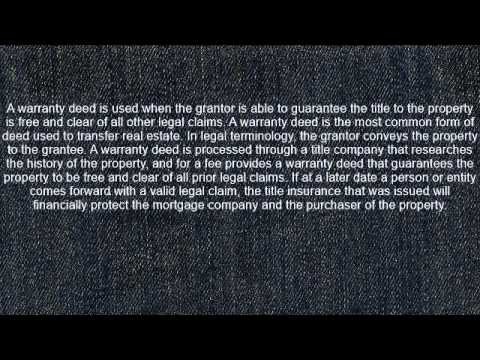What s the Difference Between Quitclaim and Warranty Deeds
Post on: 7 Май, 2015 No Comment

What’s the Difference Between Quitclaim and Warranty Deeds?
Deeds are documents that pass real estate from a current owner to a new owner. This is not a contract of sale where money changes hands when ownership changes. A deed is a document that conveys ownership without exchanging anything except the property description, location, name of previous owner and name of new owner.
All-Inclusive Document
In acknowledgement of the transfer of a piece of property, a deed tells the new owner the location of the property:
• True address
Some deeds use metes and bounds to describe the boundaries and identify locations of in-ground monuments, property lines and closest landmarks – if they exist. The document identifies who is surrendering the property (grantor) and who is accepting it (grantee). Most counties in the continental United States also require addresses of all parties participating in the property exchange.
Status of Deed Information
Every piece of information on a deed must be accurate. This includes the legal description and coordinates of the property. An incorrect statement here could lead the new owner to place a shed or a fence on neighboring property.
People’s names are the common mistakes, especially in the case of a single woman owner who marries and decides to sell the property. Her name must identify her by the name in use when she was single as well as the name she took when she wed. Failure to do this leaves a “cloud” on the deed and the title of the property.
Types of Deeds: The Warranty
There are two types of deeds: a quitclaim deed and a warranty deed. The warranty deed contains a statement warranting that the grantor owns the property free and clear of all liens. This deed most often represents a transfer of property, tells the world that the grantor is the rightful owner, and can transfer that ownership when it is sold or exchanged.
Most important is the fact that the grantor is saying that no outstanding claims exist on the property that involve lenders using it as collateral or other creditors trying to settle a bill. The property warranty deed must be truthful and clean with no one on earth having a better claim to the title. If a buyer finds out differently, the grantor must provide compensation for the mistake, which can be through the title insurance policy.
Types of Deeds: The Quitclaim
The quitclaim deed is slightly different because money does not change hands and there is no sale of property. There are certain times when this deed issues:
• Owner dies and a will declares disposal of property to an heir

• Owner marries and adds spouse’s name to title
• Owner divorces and removes ex-spouse from title
• Owner transfers property to a living trust
A quitclaim deed does not have any statement of warranty, giving a flimsy level of protection to the transfer. It tells the beneficiary that the grantor does not warrant what (s)he owns, but is transferring the property the grantor thinks (s)he owns. There is no recourse if there is a problem with the title or if a lien holder, previously thought to be non-existent, crawls out of the woodwork.
The Quitclaim Risk
No title insurance policy exists as protection against the above event. This is the reason for limiting the quitclaim to transfers within the family. Seemingly, the blatant risk becomes less likely.
There are times when the use of a quitclaim and a warranty occur simultaneously. An owner might warranty a structure and the surrounding property, but issue a quitclaim on the extended property. Doing so sends the message to a grantee that the grantor hasn’t a clue as to how far the property really extends.














